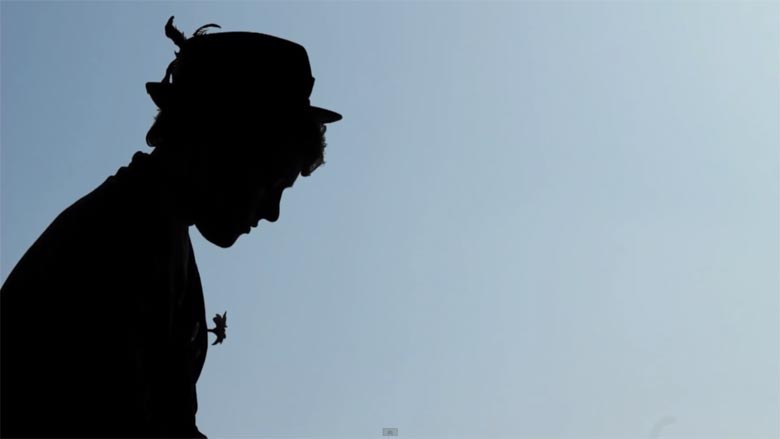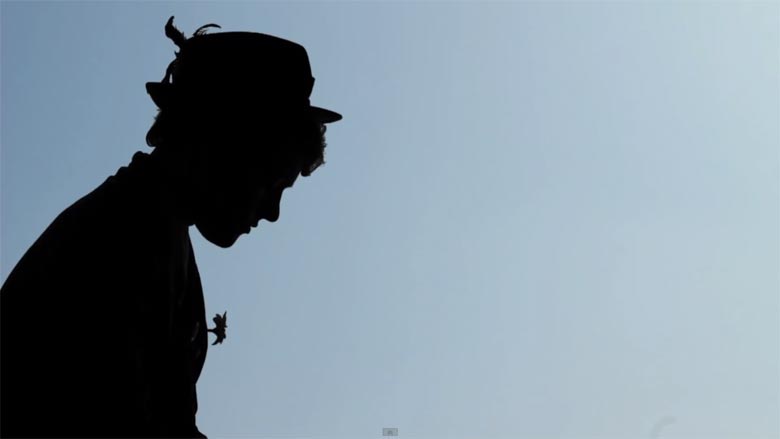In the music video for “Je Suis la Montagne”, psychedelic art rockers Moodoïd have collaborated with director Jérôme Walter Gueguen a true work of surrealist-inspired art. With a relatively minimal budget and ample film school training, they’ve turned childhood recollections of mountains into a Magritte-coloured world of soil-covered faces and tasteful (as well as tasty) object manipulation.
In this two-sided, bilingual Q&A interview, we speak with fast friends Jérôme Walter Gueguen and Moodoïd’s frontman Pablo Padovani on their friendship, collaboration, and shared inspirations. Moodoïd’s self-titled EP is now out on Entreprise, a division of Third Side Records.
How did this artistic collaboration come to form, and how much of an exchange of ideas was there?
Jérôme Walter Gueguen:
Pablo is not only a musician; he is also a very good director. You should see his brilliant short film: “The Funaire”. So when he asked me to make a music video for his group, I plunged with pleasure into his universe. I wanted to make the video as he would have done himself.
Pablo told me, “I want to be a mountain”; I said, “Okay,” and I went out to buy three bags of soil. We also had several classic writing sessions where we discussed our desires and ideas.
Pablo n’est pas seulement musicien, il est aussi un très bon réalisateur. Il faut voir son brillant court métrage: «Le Funaire». Alors quand il m’a demandé de réaliser une vidéo musicale pour son groupe j’ai plongé avec plaisir dans son univers. J’ai voulu réaliser la vidéo comme il l’aurait fait lui même.
Pablo m’a donc dis «je veux être une montagne», j’ai dis «d’accord» et je suis allé acheter trois sacs de terre. Nous avons eu aussi plusieurs sessions d’écriture classique où nous avons discuté de nos envies et de nos idées.
Pablo Padovani:
Is there a narrative or philosophy threaded throughout this music video?
Jérôme Walter Gueguen:
Pablo Padovani:
This music video reminds me of a bit of Rene Magritte’s specific type of surrealist imagery due to the colors, clouds, general trippiness, etc. Does surrealism or Magritte in particular play a role in influencing any of your art (visual or audio)?
Jérôme Walter Gueguen:
Pablo Padovani:
Surrealism has always been a major source of inspiration. For the strength of the images it provides, for the mystery and fantasy that also inspires me. The music that I write is often very crude and very instinctive. They come from the depths in the way that some surrealist poets I admire also wrote, automatically. For music videos with Jerome, we have other projects and we like to proceed by keywords and lists. We watched and made lists of words that inspire us and gave us directions to work with. Then this is the collage [portion]: gathering good ideas together. It is very feeling-oriented for us, and in preparation, we are working a lot separately, but in any case, when we work together, things happen naturally like that.
In Magritte[‘s work] what is exciting are the choice of colors and simple and profound inspiration of each painting. They are all independent of each other. In the video for “Je Suis La Montagne”, we find this idea of independent frames with strong ideas. The only difference is that a lot of images that are linked quickly around a single theme. I like this idea of creating a variation around a single theme. What is united, as in Magritte œuvre is the choice of colors that Jerome established. A song is like a list of words and images. Like the Surrealists, we are simply making an “Exquisite Corpse”.
Le surréalisme a toujours été une source principale d’inspiration. Pour la force des images qu’il procure, pour le mystère et aussi pour la fantaisie qu’il m’inspire. Les musiques que j’écris sont souvent très brut et très instinctives. Elles viennent des profondeurs à la manière de certains poètes surréalistes que j’admire et qui écrivaient de cette manière, automatique. Pour les clips, avec Jérome nous avons d’autres projets et nous aimons procéder par mots clés et par listes. On se voit et on fait des listes de mots qui nous inspirent et qui nous donnent des directions de travail. Ensuite c’est du collage: rassembler les bonnes idées ensemble. C’est très ressent pour nous et en cours d’élaboration car nous travaillons beaucoup séparément mais en tous cas, quand on travaille ensemble, les choses se passent naturellement comme ça.
Chez Magritte se qui est passionnant sont le choix des couleurs et l’idée simple et profonde qu’inspire chacune des toiles. Elles sont toute indépendantes les unes aux autres. Dans le clip de “Je Suis la Montagne” on retrouve cette idée de vignettes indépendantes avec des idées fortes. La seule différence c’est que ce sont beaucoup d’images qui s’enchaînent rapidement autour d’un même thème. J’aime cette idée de créer une déclinaison autour d’un seul thème. Ce qui les unis, comme dans l’œuvrede Magritte est le choix des couleurs qu’a établi Jérome. Une chanson est un peu comme une liste de mots et d’images. Comme les surréalistes nous faisons simplement un “Cadavre Exquis”.
Costuming and props are fairly vital to this music video. How much was pre-planned versus created spontaneously in the moment?
Jérôme Walter Gueguen:
First, I chose two colors for the accessories and clothing: brown and blue. Being limited in color helps to make quick choices.
Pablo then asked me about the gold glitter, so I imagined the reflection of the sunset in a high mountain lake.
We then made a list of objects and situations. Once we were in the studio, we distributed objects on the floor in a corner of the studio. We then tried, combined, and removed situations presented on the list. We opened up, and improvisation and ideas began to spurt from all sides. I just had to catch them in the air.
About the costumes: when Pablo told me about the mountain, I immediately thought of the Tyroleans. Since I was young, I heard a lot of jokes about the Tyroleans. Europeans mock this culture a lot. When I make a film or video, I am always attracted by prejudice, I am pressed with pleasure to try and break them down gently. So I did a little research and I quickly realized that the Tyrolean culture was absolutely wonderful: its architecture, costumes… Every year, they made a carnival in the mountains, with incredible wooden masks. I asked Pablo if he agreed, and the idea became energized. We went to thrift stores and we bought blue clothes, brown, and suspenders with edelweiss flowers. Then we started to work on costumes.
Tout d’abord j’ai choisi deux couleurs pour les accessoires et les vêtements: le marron et le bleu. Se limiter en couleur aide à faire des choix rapides.
Ensuite Pablo m’a demandé des paillettes dorées, alors j’ai imaginé le reflet du couché du soleil dans un lac de haute montagne.
Nous avons donc fait une liste d’objets et de situations. Une fois que nous étions en studio, nous avons réparties les objets par terre dans un coin du studio. Nous avons ensuite essayé, combiné, supprimé les situations présentes dans la liste. Nous avons ouvert ainsi la voix à l’improvisation et les idées ont commencé à fuser de toute part. Je n’avais qu’à les attraper en l’air.
A propos des costumes: lorsque Pablo m’a parlé de la montagne, j’ai tout de suite pensé aux tyroliens. Depuis que je suis tout jeune j’entend beaucoup de blagues sur les tyroliens. Les européens se moquent beaucoup de cette culture. Quand je réalise un film ou une vidéo je suis toujours attiré par les préjugés, je m’y enfonce avec plaisir pour essayer de les briser en douceur. Alors j’ai fait un peu de recherche et je me suis vite rendu compte que la culture tyrolienne était absolument merveilleuse: son architecture, ses costumes… Tous les ans ils font un carnaval en montagne, avec des masques en bois incroyables. J’ai demandé à Pablo s’il était d’accord et l’idée l’a beaucoup excité. Nous sommes allé dans les friperies et nous avons acheté des vêtements bleus, marrons, et des bretelles avec fleurs d’edelweiss. Puis nous avons commencé à travailler les costumes.
How much of a budget did you have to work with – and how much of it went towards glitter and miscellaneous shiny objects?
Jérôme Walter Gueguen:
We are very proud of the budget, but we never talk about because we are afraid that then we’ll be asked to make videos on mini-budgets only; we spent only 500 euros. In fact, we worked hard, and many friends, technicians, and artists worked for free. Tristan Minault, the first assistant director, accompanied the project from its writing draft phase. We shot two days with the group, and two other days for details.
Regarding glitter, one must explore the streets around the Market Saint-Pierre in Paris, between Antwerp and Abbesses. There is one with Indian selling pots with infinite content. We bought only two, but I can tell you that there is a corner of my garden that will forever golden.
Nous sommes très fier du budget mais nous n’en parlons jamais car nous avons peur que l’on nous demande ensuite de ne faire que des vidéos à mini-budget: nous n’avons dépensé que 500 euros. En réalité nous avons beaucoup travaillé en amont et beaucoup d’amis techniciens et artistes ont travaillé dessus gratuitement. Tristan Minault, le premier assistant réalisateur a accompagné le projet dès sa phase d’écriture. Nous avons tourné deux jours avec le groupe et deux autres journées pour les détails.
Pour ce qui est des paillettes il faut explorer les rues autour du Marché Saint-Pierre à Paris, entre Anvers et Abbesses, il y a des indiens qui vendent des pots aux contenus infinies. Nous n’en avons acheté que deux mais je peux vous affirmer qu’il y a un coin de mon jardin qui sera pour toujours doré.
Pablo Padovani:
Do you have any favorite imageries from music videos?
Jérôme Walter Gueguen:
The Strokes’ “Someday” clip, filmed in 16mm, is a compendium of nostalgia and friendship.
The only time that we can see the singer is really singing, is when he closes his mouth but the voice continues, because it is not the timing or the technique that counts, but the sensation.
Le clip Someday des Strokes,filmé en 16mm, est un condensé de nostalgie et d’amitié.
Le seul moment où l’on voit le chanteur vraiment chanté, celui ci ferme la bouche mais la voix continue parce que ce n’est pas la synchronisation ou la technique qui compte mais la sensation.
Pablo Padovani:
Do you think there are certain philosophies, interests, or aesthetic overlaps that make you particularly good collaborators?
Jérôme Walter Gueguen:
Pablo Padovani:
Ω
Moodoïd – “De Folie Pure” Music Video
Ω










love it, leaching inspiration off and throwing inspiration at one another